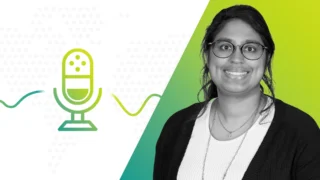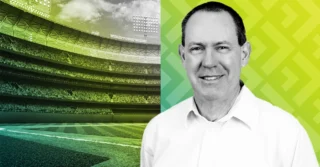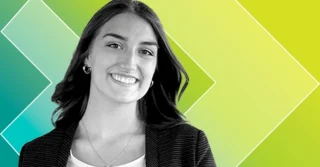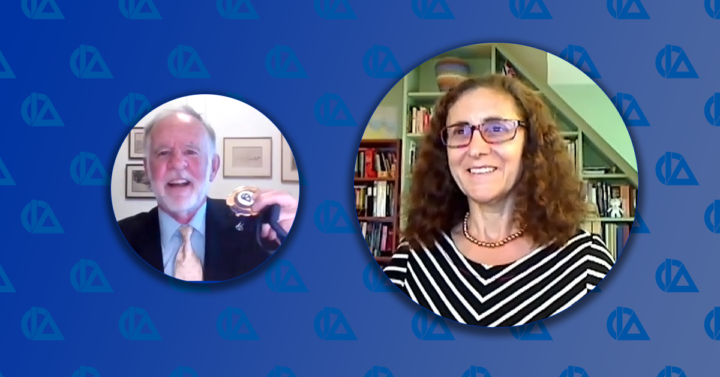
“One piece of advice I would give others is if you see a need, raise your hand. If you don’t understand something, ask a question and if you are not satisfied with the answer, get involved to make it better.”
On July 1, 2021, Jacqueline Friedland, FCIA, begins her term as CIA President. Get to know Jacque in this new episode of Seeing Beyond Risk as she shares her vision for the future and her plans to address diversity in the profession, climate change, emerging areas of practice, and more.
Listen to our podcast interview with Jacque or read the transcript below.
Looking ahead to the coming year – as we slowly get back to normal, what things are you most looking forward to?
Ah – the question we have all been speaking and thinking about this for ages! I began to prepare for this podcast on the Sunday afternoon of Victoria Day weekend. That evening, I asked this first question (“what are you most looking forward to doing again”) to my family, including my husband’s parents who we were allowed to have for dinner on our backyard deck, six feet away, for the first time in ages. Travelling was the first thing my husband and his parents said. Then my husband spoke about participating in sports teams again (he can’t wait to get back to his ultimate and hockey teams) and going to sporting events (TFC, Blue Jays, Raptors). And with equal enthusiasm my husband and his parents spoke about going to concerts and plays.
I also thought of travel first – but not in the way my husband and his parents did. They want to get back to exploring the world, and I’m not in such a hurry to do that to be honest. I tend to be extremely risk averse and am not in such a hurry to travel just like we used to. I do want to see my son in BC who I haven’t seen since January 2020! And I want to see my mother and siblings and my nieces and nephews in the US – but with vaccine rates of just over 30% in Georgia, I’m not running home yet. And I so want hugs from friends and family (beyond those living in my house, my bubble)!
And next, I want to get back to dancing! For me, the pandemic started when I was on a salsa dancing trip in Cuba with my husband. We left Toronto on Friday night March 6 (I remember chuckling with one of the younger members of our group who’s mother had insisted she wear a mask at the airport), and I returned on Saturday March 14 (my husband a few days earlier). Every day of that vacation, we watched on our phones as the world seem to shut down – the stock market took a deep dive, cruise ships were stranded at sea, borders were closed, businesses sent employees home, and quarantine requirements were instituted for return travelers (which Tom and I came home to). Thus, to me, it will really feel over, when I can return to dance.
And after dancing, I want to meet for book club in person, and I want to see my actuarial colleagues (and meet new ones) in person. And I will happily join my husband at sporting events and concerts and theatre! And I do have some travel already booked – San Francisco for a girls trip the first weekend of December and in late December, a trip to London with my husband and any of our sons who want to join us.
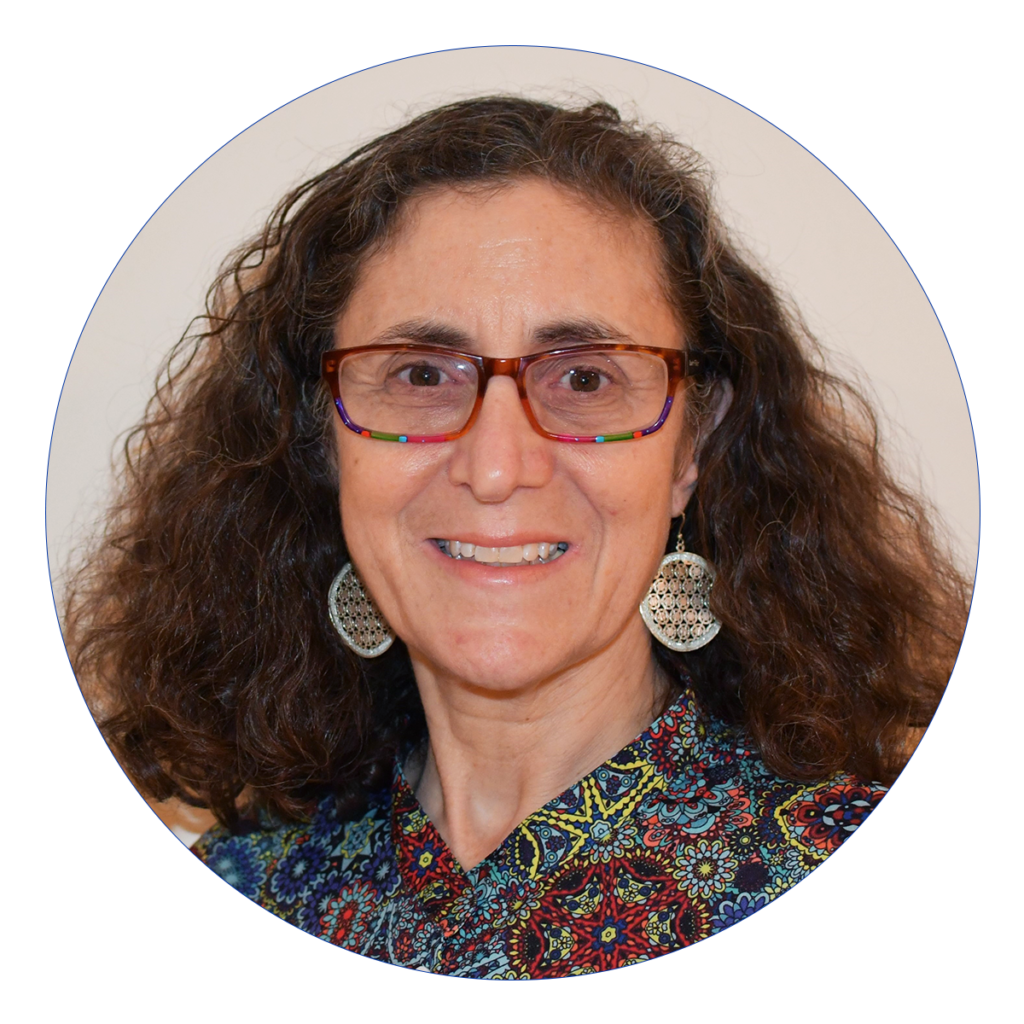
Diversity has been an issue that you have championed during your time as President-Elect. What initiatives do you plan to pursue in this area in the next 12 months?
I am so thrilled by all that we have accomplished this past year! I believe that we are in a really good place today, knowing what our strengths and our weaknesses are in this area.
I like to think about issues related to DEI in the context of how can we take quick, decisive action to address important matters today and what seeds do we need to plant now to ensure success in this area in the long-term as well.
For example, we need to increase the diversity in our speakers now – and by this I refer not to the moderator of panels but to those who speak on the panels as the subject matter experts. A critical message I learned last year in attending the annual International Association of Black Actuaries (IABA) conference and in reading and listening to much about racial issues in particular – is the importance of seeing yourself in your profession. Thus, when students go to career fairs, they need to see themselves in those who are speaking about being an actuary. Similarly, when actuarial candidates and young actuaries go to actuarial conferences (whether for CPD, networking, or other purposes), they need to see themselves in the subject matter experts speaking on panels. This will continue to be a high priority for me. I want the CIA to track the demographics of our speakers at conferences, webinars, workshops, etc.
This year, I also want to ensure that we take the diversity of our membership into consideration as we think about succession planning of our committee and council chairs and other CIA leadership roles. These are two examples where we can have immediate effects.
From a longer-term perspective, I am entirely committed to the CIA hosting, in partnership with IABA, a virtual program for “Take Our Kids to Work Day” targeted at a middle school in western Canada with a significant Indigenous population. We will run this as a pilot so we can test and learn and then be able to expand the offerings in future years – hopefully running in person in Toronto and Montreal at schools with high proportion of Black students while also continuing to run in Western Canada. I have told the CIA and IABA during several calls that I will really feel like I failed if we don’t make this happen in 2021 – especially since we have been speaking about this since early fall 2020.
We do not see DEI as something passing but instead its importance is making its way into our DNA – into the way we think, operate, interact, carry out the business of the CIA.
To ensure proper oversight and that DEI remains a high priority, we will be creating a DEI Advisory Group over the summer. Its mandate will be to:
- Identify opportunities for the CIA improve DEI elements;
- Determine requirements for any short-term working group or task force;
- Set goals and targets relating to DEI;
- Monitor key performance indicators and metrics;
- Evaluate change efforts and outcomes; and
- Champion issues and activities relating to DEI within the membership.
In closing on this topic, I want to share that I truly believe this past year has changed us in a profound and meaningful way that gets to our core. I feel that we (the CIA volunteers and professional staff) do not see DEI as something passing but instead its importance is making its way into our DNA – into the way we think, operate, interact, carry out the business of the CIA. At our June board meeting, we will discuss proposed changes for the wording of our vision, mission, and values to better reflect the importance of diversity and inclusion as well as our educational plans. We continue to learn from our guest speakers and from attending other organizations’ events and reading on the topic – we call one another out in a constructive manner – we are learning, we are getting better – and I am so proud to have been part of this change.
We have announced some very exciting changes when it comes to education. What is your perspective on this, and what changes will the CIA start working on this year?
I could not be more excited about our plans for the three educational pathways! Over the past month, we held numerous sessions with stakeholders – employers, regulators, WC boards across Canada, actuarial associations in the US and around the world. We were often told that our excitement could be felt through the Zoom boxes on the screen.
This has been a long time coming. The CIA leadership – volunteers and professional staff – have spoken about the need to have a “made in Canada” route to Fellowship for decades. We are the only major national actuarial organization in the world without its own path to Fellowship. Regardless of all the historic discussions, now is the right time! The work of the actuary continues to evolve and is changing rapidly as technology continues to advance at warp speed. What one needs to know to be successful in the future is changing. Furthermore, the delivery of education and the assessment of the knowledge gained from that education is changing, especially given the experience of the past 16 months with COVID.
For our pathway one to Fellowship, the 100% Canadian route, the CIA has an incredible opportunity of starting with a clean slate. We will be able to partner with our universities who are experts in teaching students how to learn.
The work of the actuary continues to evolve and is changing rapidly as technology continues to advance at warp speed. What one needs to know to be successful in the future is changing.
And I want to diverge for a minute and speak about this – “being taught how to learn.” We had a great family discussion at the dinner I referred to earlier with my husband’s parents. My father-in-law, who was a former dean of the UofT law school, and my mother-in-law, who was a former head of Occupational Therapy at UofT, had a very engaging discussion with my 20-year old son and his girlfriend who had just returned from Montreal and their year of virtual learning at McGill. They spoke about their classes and how they learned how to learn and the importance of that in today’s world when so much information is at our fingertips.
At the CIA, we intend to build on the strong university relationships of the past decade to expand the UAP from an exam-mapping type of credit to a recognition of the entire degree for the basis of Associateship (supplemented with an Associate module, capstone exam, and professionalism workshop).
We will then work with educational experts, including Canadian universities and other organizations who are in the business of education, to create the Fellowship modules and exams. We will engage members as volunteers utilizing their subject matter expertise in the Fellowship tracks – not to write or grade exam questions as historical models have done – but instead our member volunteers will supplement the work of educational professionals.
There is much work to be done as the cohort of students entering university this fall will be eligible to follow pathway one if they so choose. We have work to do on the syllabus, updating CIA policies and program accreditation for the universities, RFPs to issue and evaluate for our professional partners, and the list goes on and on. I am confident in our education professional staff and the Education and Qualification Council. And I welcome all members who are interested in becoming involved in this important work to please reach out to me or the CIA directly.
Two topics that are attracting a lot of attention in the actuarial world are climate change and the emergence of predictive analytics. How do you see these items fitting into your agenda as CIA President?
Today, I want to speak about both of these primarily from an education perspective. We could spend hours – even days – speaking about how these two topics are changing our world, how they will change our profession, and what we should be doing from an advocacy perspective (for example, ethical biases in artificial intelligence and the disparate effect of climate change). There are conferences dedicated to these important topics. But for today, let me focus most of my comments on education and what I would like to see during my term as president of the CIA.
With respect to predictive analytics, I want to step back a few months. In the late fall of 2020, the Board formed a Predictive Analytics Working Group. At the March 2021 Board meeting, this Working Group made a presentation (including recommendations) with three key “must do” items around branding and education and five “quick-win” items to create immediate awareness, engagement and effectiveness – with all recommendations tied to the CIA’s strategic goals. The Working Group provided concrete recommendations categorized by:
- Strategic;
- Brand, promotion, and awareness; and
- Education including continuing professional development.
At that March meeting, The Board accepted all the recommendations of the Working Group and made a commitment to raise the strategic importance of enhancing and promoting predictive analytics and applications for all actuaries and to begin to do so for the next operational planning cycle.
We have already seen action on that commitment in the program offerings at the act21 conference as well as in the jointly sponsored Predictive Analytics Seminar with the CAS and SOA held in mid June. This is a one-day content-packed event that brought together practitioners from life, health, and P&C for an in-depth look at the ways actuaries are using predictive analytics to drive business outcomes.
I firmly believe that we will be able to incorporate much more depth in the area of predictive analytics in pathway one – the made in Canada route to FCIA – with delivery of education and assessment of that education at university. Delivering and assessing education in predictive analytics cannot be done in the old way of paper and pen exams. Candidates need access to data sets as well as programming and data visualization tools, and we believe that universities are best suited for this.
With respect to climate change, much of the literature I am now reading – insurance and actuarial literature – categorise the risks as transition, physical, and liability. In their recent discussion paper on climate-related risks, OSFI defines each of these three risks. Actuaries and P&C actuaries in particular, are very familiar with physical and liability risks. Physical risk arises from a changing climate where we see increased frequency and severity of wildfires, ice storms, floods, wind events, and rising sea levels, among other things. Liability risk is the potential exposure to the risks associated with climate-related litigation – think of the Florida Keys no longer being habitable and the lawsuits that could arise from home and business owners. Finally, transition risk stems from efforts to reduce greenhouse gas emission (GHG) as the economy shifts towards a lower GHG footprint. Transition risk can emerge due to current or future government policies as well as changes in investor and consumer behaviours.
With respect to transition risk, I believe we are seeing tremendous examples of this category of risk almost every day. Transitions that some expected to take decades are coming now at record pace. For example, I want to read from the headline news I woke up to this morning (that is May 27). The title of the Politico article was “Powerful signal: In a single day, Big Oil suffers historic blows on climate change.” The articles starts: “In the space of a few hours, Exxon Mobil Corp was bested by an upstart shareholder seeking to shake up the company’s board. Chevron Corp investors instructed the company to cut its greenhouse gas emissions. A Dutch court ordered Royal Dutch Shell to slash emissions by 45%. And while the oil industry was taking its hits, longtime ally Ford Motor Co widened its distance from fossil fuels.” The pace of change is almost numbing.
With respect to climate change and our education, my comments are similar to those on predictive analytics. I see an important role for Canadian universities. So much is happening so fast, and many Canadian universities have programs and/or centres of excellence related to climate change. In shaping our “made in Canada” pathway to Fellowship, we will be able to include the best material on the syllabus and also determine how best to deliver and assess that material. We are incredibly fortunate to have a wealth of material to select from – new papers from the International Actuarial Association, the International Association of Insurance Supervisors, from numerous bodies in Europe and in Canada (such as OSFI). We have a treasure of choices – a situation that was not true in the past.
Again, I want to emphasize in both of these areas – predictive analytics and climate change, I don’t believe that the CIA needs to recreate any wheels. Instead, I want to see us leverage existing material and partner with others. We have much we can add to the discussion, and we need to collaborate – and we need to approach our work in an agile way, testing and learning and pivoting as needed. I know these are the buzz words of today. But I have had the privilege to see how effective organizations can be when they operate in such a way.
As always, the success of the CIA depends very much on the engagement of our members and their volunteer efforts. How has this been instrumental in your career, and what advice do you have for members looking to get involved?
I am a people person and get energy from my interaction with others – whether in my family, social circles, at work, and when volunteering. If I look back to my early days as an actuarial student, I always studied in groups, feeding on that energy to keep me going. After becoming a Fellow, I was quick to volunteer on exam and other education committees. And when I moved to Canada more than 20 years ago, I looked for opportunities to volunteer and get involved with the CIA.
I will share a story of how I first got involved in the CIA. I remember attending a CIA conference – I think it was an AA seminar. I was in Canada less than a year, and did not have much of a network at all. I can’t remember the exact subject matter of the session – though I do recall it was a plenary session and there were a lot of people in a giant room – the speakers referred repeatedly to materiality. I stood up, walked over to one of the mics in the aisles, introduced myself and asked the speakers to please expand on what was materiality and what did they mean. I recall that no one could give a very clear answer and, at the time, there was no guidance on the subject in the CIA literature. There and then, I volunteered to lead a group to draft a paper on the topic. A paper that remains on the CAS exam 6 syllabus to this day.
And that raised hand led to countless other opportunities. So one piece of advice I would give others, is if you see a need, raise your hand. If you don’t understand something, ask a question and if you are not satisfied with the answer, get involved to make it better.
When asked for advice about getting involved – about volunteering – all the usual things ring so true. It is a terrific way to build your network. You get more than you give. It provides great intellectual stimulation. Many of my closest friends are those who I have volunteered with – I look at my women’s book club, which has run for more than a decade and includes many actuaries who I have worked or volunteered with. And this book club has stayed stronger than ever through the year+ of COVID in Zoom. My life has been enriched by knowing and sharing times with all these people.
When we sit down again in June 2022, what accomplishments do you hope that you can look back upon?
This was a great question as it forced me to sit down and make a list – and I love lists, particularly “to do” lists. Next June, I want to look back at the year and see the following:
- A fantastic “Take Our Kids to Work Day” with plans for fall 2022 and an even stronger partnership with IABA that extends beyond Alicia and me and the leadership of the Toronto and Montreal IABA chapters – a relationship that extends across more members of both organizations – and I want more employers in Canada to be using the HR Guide that the IABA created in 2020, which is outstanding
- Beginning to see interest from indigenous youth in our profession as a result of our outreach and that of the AFC
- More diversity in speakers at all CIA events and a system of DEI metrics that is being used to help guide decision-making and action
- A plan to make changes that result in more women staying in the profession, recognizing that this is a big issue and one that the CIA is most likely not responsible for on its own as there are far more societal issues driving this
- Significant progress for the new made in Canada pathway, including the banking path and more climate change material on our syllabus
- Progressing well on our commitments to predictive analytics
- Beginning of work on succession planning for CIA leadership (board, committee, and councils) as I see this as a potential operational weakness that needs some attention
- And a new issue that I just learned about this week is related to gender and gender fluidity and a recent related court decision. I expect that we will set up a Board task force to begin looking at this and beginning to understand the implications to actuarial work in Canada – our research, standards of practice, educational guidance, etc.

